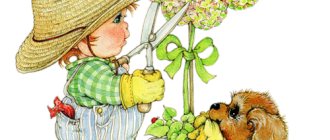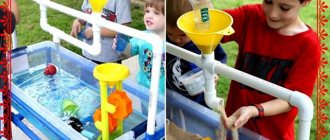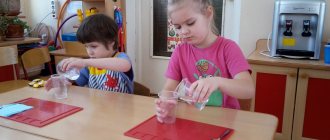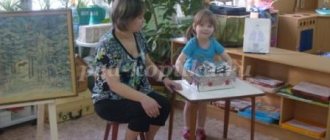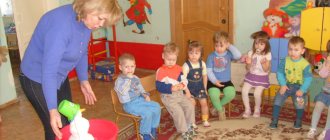Card index of experiences and experiments on a walk with children of the second junior group
Maria Zaitseva
Card index of experiences and experiments on a walk with children of the second junior group
Experiment 1. Properties of sunlight (on a walk)
Target:
familiarization with the properties of sunlight (water evaporates under the influence of sunlight).
Material:
rubber balls, watering can with water.
Description of the experience
On a sunny day, while out for a walk, wet rubber balls, put them in the sun and watch them dry.
Conclusion.
Water evaporates when exposed to sunlight.
Experiment 2. Why didn’t the pie turn out?
Target:
familiarization with the properties of sand (dry sand is free-flowing, Easter cakes cannot be made from it; wet sand, Easter cakes can be made from it).
Material:
sand, molds.
Description of the experience
The teacher pours sand into the mold. Trying to make a pie. The sand from the mold crumbles. Children pick up sand. Sand spills out of children's hands. The teacher wets the sand with water and tries again to make a pie. The pie turned out. The teacher gives the children the opportunity to touch the sand and determine that it is wet. A pie can only be made from wet sand.
Conclusion.
The sand is dry. It is light in color and free-flowing. You cannot make a pie out of dry sand. When wetted, the sand becomes wet and dark in color. You can make a pie from wet sand.
Experiment 3. Wind.
Target:
familiarization with the properties of air (movement, direction).
Material:
paper pinwheels, plumes.
Description of the experience
Children on a walk play with turntables. Together with the teacher, they discuss why they spin, determine the speed, strength and direction of the wind using the spinners. They also look at trees and determine the strength of the wind by the inclination of the branches.
Conclusion.
In the presence of wind, the blades of paper pinwheels and plumes rotate slowly or with acceleration. The direction of the wind can be determined by the rotation of the turntable blades. The speed, strength and direction of the wind can also be determined by the inclination of the branches on the tree.
Experiment 4. Properties of ice.
Target:
familiarization with the properties of ice (thin, fragile).
Material:
ice.
Description of the experience
The teacher breaks the ice with a shovel. Children, under the guidance of a teacher, examine pieces of ice. Place a piece of ice on your palm and watch it melt.
Conclusion.
Summer melts from the heat just like snow.
Experiment 5. The snow in the room is melting.
Target:
familiarization with the properties of snow (it melts and turns into a liquid state when the air temperature rises).
Material:
snow, jar.
Description of the experience
During the walk, the teacher collects snow in a jar and places it in the group room. Children, under the guidance of a teacher, watch the snow.
Conclusion.
The room heat will melt the snow and form water. Draw children's attention to the fact that the water is dirty.
Experiment 6. Properties of snow.
Target:
familiarization with the properties of snow (snow melts when the air temperature rises).
Material:
snow.
Description of the experience
During a walk, a teacher takes snow in his hands and shows the children how it slowly melts from the heat.
Conclusion.
The palm is warm, the snow melts from the heat.
Experiment 7. Properties of sunlight.
Target:
familiarization with the properties of sunlight (heating objects).
Description of the experience
The teacher invites the children to touch the walls of the house on the sunny side and on the shady side. Ask why the wall is cold in the shade and warm in the sun. Offer to expose your palms to the sun and feel how they warm up.
Conclusion.
Objects in the shade, without access to sunlight, are colder. Objects located on the side heated by the sun's rays are warmer.
Experiment 8. “Sunny bunnies”
Target:
give the idea that a “sunbeam” is a ray of sun reflected in a mirror.
Description of the experiment:
The teacher demonstrates the appearance of a sunny “bunny”, accompanying his actions with words. The mirror reflects a ray of light, and the mirror itself becomes the source of light. You can make sunny “bunnies” thanks to the sun.
The teacher shows the children how to let in sun “bunnies”.
— Catch a ray of light with a mirror and direct it in the desired direction.
Children are trying to release sun “bunnies”. Then the teacher shows how to hide the “bunny” (cover the mirror with your palm). Children try to hide the “bunny”. Next, the teacher invites the children to play hide and seek and catch up with the “bunny”. Children find out that it is difficult to control the “bunny” and play with it (even with a slight movement of the mirror, the sun “bunny” moves a long distance on the wall).
The teacher invites the children to let the “bunnies” into the shade, where there is no bright sunlight.
— Why don’t sun “bunnies” appear? (No bright light).
Conclusion:
The sunny “bunny” appears by reflecting light from shiny surfaces.
Experiment 9. Properties of water (one of its states).
Target:
familiarization with one of the properties of water.
Material:
icicle (piece of ice).
Description of the experience
The teacher breaks the icicle. Children, under the guidance of a teacher, examine it and touch it. Ask what it is like (cold, transparent, smooth). Bring it into a warm room and watch how it melts and what it turns into.
Conclusion.
Ice (in the form of an icicle) is hard, smooth, cold, transparent. As the air temperature rises, the ice gradually melts, acquiring a liquid state and turning into water.
Experiment 10. “Colored beads”
Target:
introduction to the properties of ice
Material:
water, paints, thick thread, molds
Description of the experience:
make beads from a candy box. Pour colored water into the molding box, alternating colors with clear water. Then put a thick, long thread for beads into the poured molds and also put them in the frost. After a while, see what happened to the water. Invite the children to decorate the trees on the site and admire the beauty that the children have made with their own hands.
Conclusion:
water freezes in cold weather
Experiment 11. Why did streams run along the roads?
Target:
familiarization with the properties of snow (melts and turns into water).
Description of the experience
The teacher invites the children to look at the road in the shady side of the house. Note that there is snow on the road. Ask: “Why?” (There is no sun, there is snow on the road.)
The teacher invites the children to look at the road on the sunny side of the house. Note that streams run along the road. Ask: “Why?” (The sun heated the snow and turned it into water.)
Conclusion.
The sun heats the snow and it turns into water.
Experiment 12. Paper boats.
Target:
familiarization with the properties of paper gets wet in water.
Material:
paper boats.
Description of the experience
The teacher makes paper boats for the children, lets them touch them, asks what they are like (hard, paper). He takes the boats out for a walk and gives them to the children. Children launch boats into a puddle or stream. Watch them get wet. The teacher asks why the boats get wet.
Conclusion.
The paper gets wet in water and tears.
Experience 13. Fun boats.
Target:
familiarization with various properties of objects (buoyancy of objects).
Material:
basin with water (streams); objects made from different materials.
Description of the experience
The teacher pours water into a basin (they approach the stream) and, together with the children, lowers objects made from different materials. Observe which objects sink and which remain floating.
Conclusion.
Not all objects float, it all depends on the material from which they are made.
Experience 14. What's in the package?
Target:
detection of air in the surrounding space.
Material:
plastic bags.
Description of the experience
Children look at an empty plastic bag. The teacher asks what is in the package. Turning away from the children, the teacher fills the bag with air and twists the open end so that the bag becomes elastic. Then he shows a closed bag filled with air and again asks what is in the bag. He opens the package and shows that there is nothing in it. The teacher draws the children's attention to the fact that when they opened the package, it ceased to be elastic. He explains that there was air in it. He asks why it seems that the package is empty (the air is transparent, invisible, light).
Conclusion.
The air is transparent, invisible, light.
Experiment 15. Properties of wet sand.
Target:
familiarization with the properties of sand (dry sand crumbles, wet sand molds, it dries under the influence of sunlight).
Material:
sand, watering can with water, molds.
Description of the experience
Wet the sand and watch with the children how it dries. Try making a cake from dry and wet sand using molds. Compare, draw a conclusion.
Conclusion.
Wet sand molds, you can sculpt different shapes from it; dry sand crumbles. Wet sand dries in the sun.
Experiment 16. Making paths and patterns from sand.
Target:
familiarization with the properties of sand (any pattern can be made from dry sand, but not from wet sand).
Material:
sand, watering can with water, bottle.
Description of the experience
The teacher gives the children plastic bottles filled with dry and wet sand and shows how to draw patterns on the ground. Wet sand does not fall out of the bottle, while dry sand pours out freely.
Conclusion.
Dry sand is loose; By filling a bottle with it, you can make a path or other pattern. Wet sand is heavy and does not fall out of the bottle.
Experiment 17. “Sand and Earth”
Target:
familiarization with the properties of sand (loose) and earth (dry, hard).
Description of the experience:
Each child has a pot (bucket) with sand, a jar (bucket) with soil and two “trees” (tree branch). The teacher invites the children to “plant” a tree in a bucket of soil, and then in a bucket of sand. Children compare which is easier to plant a tree in.
Conclusion:
the earth is dry, hard, and the sand is crumbly.
Experiment 18. “Determination of color.”
Target:
familiarization with the properties of sand (color).
Progress:
Look carefully, what color do you think the sand is? (Light yellow).
- Now let’s pour water on it. What color is the sand? (Dark)
Conclusion.
Dry sand is light, and wet sand is dark.
Experimentation group 2 junior group
Course objectives:
Development of children's cognitive activity in the process of experimentation;
Development of observation, ability to compare, analyze, generalize, development of children’s cognitive interest in the process of experimentation, establishment of cause-and-effect relationships, ability to draw conclusions;
Development of attention, visual and auditory sensitivity;
Creating the prerequisites for the formation of practical and mental actions in children.
Tasks:
1. To form in children the initial foundations of systematic knowledge about living and inanimate nature.
2. To develop knowledge, skills and abilities of creative activities filled with environmental content.
3. Develop and enrich figurative memory, thinking, sensorimotor intelligence.
4. Enrich the vocabulary and develop the speech of children of primary preschool age.
Lesson duration 10-15 minutes
Methods:
1. Preliminary work (observations, reading, conversations, consideration) to study the theory of the issue. 2. Determining the type of activity and subject of the experiment. 3. Selecting the goals of tasks for working with children (cognitive, developmental, educational tasks). 4. Game training of attention, perception, memory, thinking. 5. Preliminary research work using teaching aid equipment. 6. Selection and preparation of aids and equipment, taking into account the age of the children of the topic being studied.
Material:
1. Beads, buttons. 2. Ropes, laces, braid, threads. 3. Plastic bottles of different sizes. 4. Multi-colored clothespins and elastic bands.
5. Pebbles of different sizes. 6. Cogs, nuts, screws. 7. Traffic jams. 8. Down and feathers. 10. Cocktail straws 11. Plastic bags. 12. Seeds of beans, beans, peas, seeds, nut shells. 13. Cotton wool, padding polyester. 14. Kinder surprises
15. Sand.
16. Water and food coloring.
17. Different grades of paper
Approximate structure of an experiment lesson
1. Statement of the research problem. 2. Training of attention, memory, logic of thinking. 3. Clarification of life safety rules during experimentation. 4. Clarification of the research plan. 5. Selection of equipment and placement by children in the research area. 6. Distribution of children into subgroups. 7. Analysis and generalization of the experimental results obtained.
Relevance of the program
The main advantage of the program is that it is based on the method of teaching preschoolers - experimentation, which gives children a real idea of the various aspects of the object being studied. In the process of experimentation, the child’s memory is enriched, his thought processes are activated, since the need constantly arises to perform operations of analysis, comparison, classification, and generalization. Creative abilities are being developed, work skills are being formed, and vocabulary is being enriched. Children's experimentation is characterized by a high level of independence: the child sets goals himself, sets goals himself, achieves them himself, gaining new knowledge about objects and phenomena
